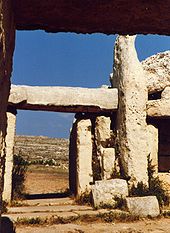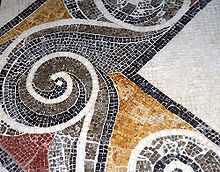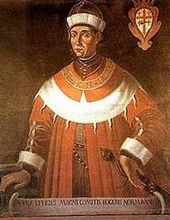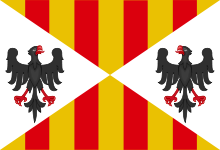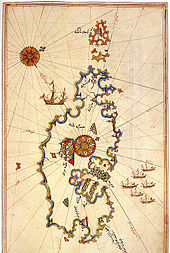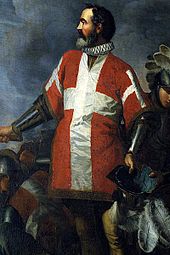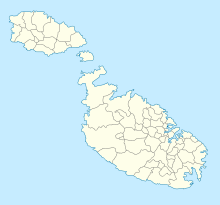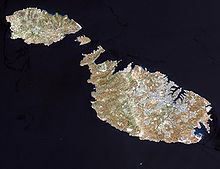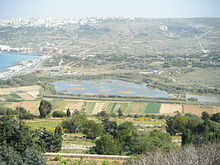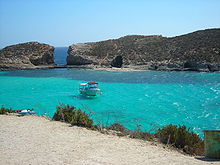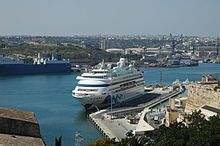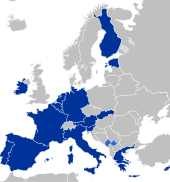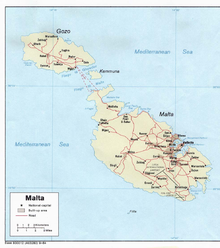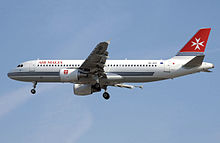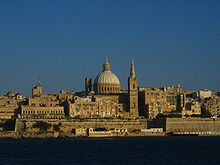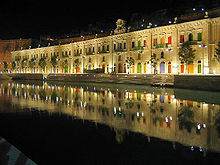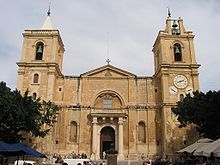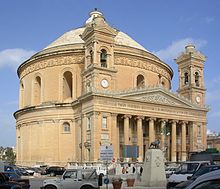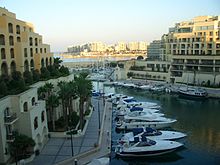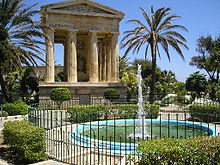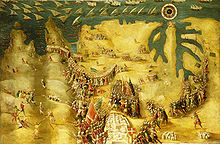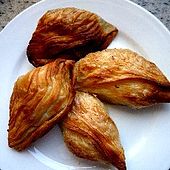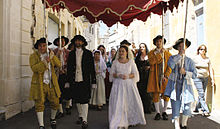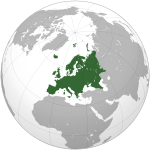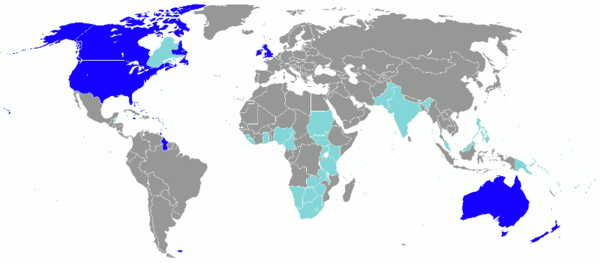- Malta
-
Republic of Malta Repubblika ta' Malta

Flag Coat of arms Anthem: L-Innu Malti
The Maltese Anthem
Location of Malta (dark green)– in Europe (green & dark grey)
– in the European Union (green) — [Legend]Capital Valletta
35°53′N 14°30′E / 35.883°N 14.5°ELargest city Birkirkara 35° 53′ 48″ N, 14° 27′ 45″ E Official language(s) Maltese, English Ethnic groups (2007) Maltese 95.3%, British 1.6%, other 3.1%[1] Demonym Maltese Government Parliamentary Republic - President George Abela - Prime Minister Lawrence Gonzi Independence - from the United Kingdom 21 September 1964 - Republic 13 December 1974 Area - Total 316 km2 (200th)
121 sq mi- Water (%) 0.001 Population - 2010 estimate 417,608  [2] (171st)
[2] (171st)- 2007 census 410,567[3]1 - Density 1,306.8/km2 (7th)
3,413.9/sq miGDP (PPP) 2010 estimate - Total $10.405 billion[4] - Per capita $24,792[4] GDP (nominal) 2010 estimate - Total $8.288 billion[4] - Per capita $19,746[4] HDI (2011)  0.832[5] (very high) (36th)
0.832[5] (very high) (36th)Currency Euro (€)2 ( EUR)Time zone CET (UTC+1) - Summer (DST) CEST (UTC+2) Drives on the Left ISO 3166 code MT Internet TLD .mt 3 Calling code 356 1 Total population includes foreign residents. Maltese residents population estimate at end 2004 was 389,769. All official population data provided by the NSO.[6]
2Before 2008: Maltese lira
3 Also .eu, shared with other European Union member states.Malta
 i/ˈmɒltə/, officially known as the Republic of Malta (Maltese: Repubblika ta' Malta), is a Southern European country consisting of an archipelago situated in the centre of the Mediterranean, 80 km (50 mi) south of Sicily and 288 km (179 mi) east of Tunisia, with the Strait of Gibraltar 1,826 km (1,135 mi) to the west and Alexandria 1,510 km (940 mi) to the east.[7]
i/ˈmɒltə/, officially known as the Republic of Malta (Maltese: Repubblika ta' Malta), is a Southern European country consisting of an archipelago situated in the centre of the Mediterranean, 80 km (50 mi) south of Sicily and 288 km (179 mi) east of Tunisia, with the Strait of Gibraltar 1,826 km (1,135 mi) to the west and Alexandria 1,510 km (940 mi) to the east.[7]Malta covers just over 300 km2 (120 sq mi) in land area, making it one of the world's smallest and most densely populated countries.[8][9][10] Its de facto capital is Valletta and the largest town is Birkirkara. The main island is made up of many small towns, which together form one Larger Urban Zone (LUZ) with a population of 368,250 (majority of the population of the country) according to Eurostat.[11] The country has two official languages – Maltese and English – with Maltese being considered the national language.
Throughout history, Malta's location has given it great strategic importance,[12] and a sequence of powers including the Phoenicians, Greeks, Romans, Sicily (Arabs, Normans, Aragonese), Knights of St John, French and the British ruled the islands. Malta gained independence from the United Kingdom in 1964 and became a republic in 1974, whilst retaining membership in the Commonwealth of Nations. Since 1964 it has been a member of the United Nations and in 2004 it joined as member of the European Union. Malta is also party to the Schengen Agreement[13] and in 2008 it became part of the eurozone.
Malta has a long Christian legacy and is an Apostolic See. According to the Acts of the Apostles in the Bible,[14] St. Paul was shipwrecked on "Melite", as the Greeks called the island, and ministered there.[15] Catholicism is the official religion in Malta as declared by the Maltese constitution.[16][17]
Malta is internationally renowned as a tourist resort, with numerous recreational areas and historical monuments, including nine UNESCO World Heritage Sites,[18] most prominently the Megalithic Temples which are some of the oldest free-standing structures in the world.[19][20][21]
Contents
Etymology
The origin of the term Malta is uncertain, and the modern-day variation derives from the Maltese language. The most common etymology is that the word Malta derives from the Greek word μέλι (meli), "honey".[22] The Greeks called the island Μελίτη (Melitē) meaning "honey-sweet" (which was also the name of a Nereid[23]), possibly due to Malta's unique production of honey; an endemic species of bee lives on the island, giving it the popular nickname the "land of honey".[24] The Romans went on to call the island Melita,[25] which is the latinisation of the Greek Μελίτη.[26] Another theory suggests that the word Malta comes from the Phoenician word Maleth meaning "a haven"[27] in reference to Malta's many bays and coves.
History
Prehistory
Pottery found by archeologists at Skorba resembles that found in Italy, and suggests that the Maltese islands were first settled in 5200 BC mainly by stone age hunters or farmers who had arrived from the larger island of Sicily, possibly the Sicani. The extinction of the dwarf hippos and dwarf elephants has been linked to the earliest arrival of humans on Malta.[28] Prehistoric farming settlements dating to Early Neolithic period were discovered in open areas and also in caves, such as Għar Dalam.[29]
The Sicani were the only tribe known to have inhabited the island at this time[30][31] and are generally regarded as related to the Iberians.[32] The population on Malta grew cereals, raised domestic livestock and, in common with other ancient Mediterranean cultures, worshiped a fertility figure represented in Maltese prehistoric artifacts as exhibiting the large proportions seen in similar statuettes, including the Venus of Willendorf.
Pottery from the Għar Dalam phase is similar to pottery found in Agrigento, Sicily. A culture of megalithic temple builders then either supplanted or arose from this early period. During 3500 BC, these people built some of the oldest existing, free-standing structures in the world in the form of the megalithic Ġgantija temples on Gozo;[33] other early temples include those at Ħaġar Qim and Mnajdra.[34][35][36]
The temples have a distinctive architecture, typically a complex trefoil design, and were used from 4000–2500 BC. Animal bones and a knife found behind a removable altar stone suggest that temple rituals included animal sacrifice. Tentative information suggests that the sacrifices were made to the goddess of fertility, whose statue is now in the National Museum of Archaeology in Valletta.[37] The culture apparently disappeared from the Maltese Islands around 2500 BC. Archeologists speculate that the temple builders fell victim to famine or disease. Others have speculated on the links between this event and Plato's account of the disappearance of Atlantis.
Another interesting archeological feature of the Maltese islands often attributed to these ancient builders, are equidistant uniform grooves dubbed "cart tracks" or "cart ruts" which can be found in several locations throughout the islands with the most prominent being those found in an area of Malta named "Clapham Junction". These may have been caused by wooden-wheeled carts eroding soft limestone.[38][39]
After 2500 BC, the Maltese Islands were depopulated for several decades until the arrival of a new influx of Bronze Age immigrants, a culture that cremated its dead and introduced smaller megalithic structures called dolmens to Malta.[40]
Greeks, Phoenicians and Romans
Around 700 BC, the Ancient Greeks settled on Malta, especially around the area where Valletta now stands.[41] A century later, Phoenician traders,[41] who used the islands as a stop on their trade routes from the eastern Mediterranean to Cornwall, joined the natives on the island.[42] The Phoenicians inhabited the area now known as Mdina, and its surrounding town of Rabat, which they called Maleth.[43] The Romans, who also lived in Mdina, referred to it (and the island) as Melita.[25]
After the fall of Phoenicia, in 400 BC the area came under the control of Carthage, a former Phoenician colony.[44] During this time the people on Malta mainly cultivated olives and carobs, and produced textiles.[44]
During the First Punic War of 264 BC, tensions led the Maltese people to rebel against Carthage and turn control of their garrison over to the Roman consul Sempronius.[25] Malta remained loyal to Rome during the Second Punic War and the Romans rewarded it with the title Foederata Civitas, a designation that meant it was exempt from paying tribute or the rule of Roman law, although at this time it fell within the jurisdiction of the province of Sicily.[25]
By 117 AD, the Maltese Islands were a thriving part of the Roman Empire, being promoted to the status of Municipium under Hadrian.[25] Catacombs in Rabat testify to an early Christian community on the islands, and the Acts of the Apostles recount the shipwreck of St Paul and his ministry on the island.
When the Roman Empire split into Eastern and Western divisions in the 4th century, Malta fell under the control of the Greek speaking Byzantine Empire from 395 to 870,[41] which ruled from Constantinople.[45] Although Malta was under Byzantine rule for four centuries, not much is known from this period. There is evidence that Germanic tribes, including the Goths and Vandals, briefly took control of the islands before the Byzantines launched a counter attack and retook Malta.[45]
Middle Ages
Malta was involved in the Byzantine-Arab Wars, and the conquest of Malta is closely linked with that of Sicily due to admiral Euphemius' betrayal of his fellow Byzantines, requesting that the Aghlabid dynasty invade the area.[46] As part of the Emirate of Sicily, rule switched to the Fatimids in 909.[47] The Arabs introduced new irrigation, some fruits and cotton and the Siculo-Arabic language was adopted on the island from Sicily: it would eventually evolve into the Maltese language.[48]
The native Christians were allowed freedom of religion but had to pay jizya, a tax for following their religion.[47] The Normans, as part of their conquest of Sicily, took Malta in 1091.[25] The local Christians warmly welcomed the arrival of Roger I and offered to fight for him; in response to this, Roger reportedly tore off a portion of his checkered red-and-white banner and presented it to the Maltese, forming the basis of the present-day Maltese flag.[25]
The Norman period was productive; Malta became part of the newly formed Kingdom of Sicily which also covered the island of Sicily and the southern half of the Italian Peninsula.[25] The Catholic Church was re-instated as the state religion with Malta under the See of Palermo and much Norman architecture sprung up around Malta especially in its ancient capital Mdina.[25] Tancred of Sicily, the last Norman monarch, made Malta a feudal lordship or fief within the kingdom and a Count of Malta instated. As the islands were much desired due to their strategic importance, it was during this time the men of Malta were militarised to fend off capture attempts; the early counts were skilled Genoese corsairs.[25]
The kingdom passed on to the House of Hohenstaufen from 1194 until 1266. Malta was part of the Holy Roman Empire of the German Nation for 72 years. Malta was declared a county and a marquisate, but its trade was totally ruined. For a long time it remained solely a fortified garrison.[49] It was in 1224 under Frederick II that all remaining Muslims were expelled from Malta[50] or impelled to convert[51][52] and the entire Christian male population of Celano in Abruzzo was deported to Malta.[25]
For a brief period the kingdom passed to the Capetian House of Anjou, however high taxes made the dynasty unpopular in Malta, due in part to Charles of Anjou's war against the Republic of Genoa and the island of Gozo was sacked in 1275.[25] A large revolt on Sicily known as the Sicilian Vespers followed these attacks, that saw the Peninsula separating into the Kingdom of Naples; the Kingdom of Sicily, including Malta, then fell under the rule of the Aragonese.[citation needed]
Relatives of the kings of Aragon ruled the island until 1409, when it passed to the Crown of Aragon. Early on in the Aragonese reign the sons of the monarchy received the title, "Count of Malta". It was also during this time that much of the local nobility was created. However by 1397 the bearing of the title "Count of Malta" reverted to a feudal basis with two families fighting over the distinction, which caused much distress. This led the king to abolish the title. Dispute over the title returned when the title was reinstated a few years later and the Maltese, led by the local nobility, rose up against Count Gonsalvo Monroy.[25] Although they opposed the Count, the Maltese voiced their loyalty to the Sicilian Crown, which so impressed Alfonso IV that he did not punish the people for their rebellion but promised never to grant the title to a third party, instead incorporating it back into the crown. The city of Mdina was given the title of Città Notabile as a result of this sequence of events.[25]
Knights of Malta and Napoleon
In 1530 Emperor Charles V gave the islands to the Knights Hospitaller under the leadership of Frenchman Philippe de Villiers de L'Isle-Adam, Grand Master of the Order, in perpetual lease. These knights, a military religious order now known as the Knights of Malta, had been driven out of Rhodes by the Ottoman Empire in 1522.
In 1551, Barbary corsairs enslaved the entire population of the Maltese island Gozo, about 5,000, deporting them to the Barbary coast.
The knights, led by Frenchman Jean Parisot de la Valette, Grand Master of the Order, withstood a siege by the Ottomans in 1565. The knights, with the help of the Maltese, were victorious, and speaking of the battle Voltaire said, "Nothing is more well known than the siege of Malta."[53] After the siege they decided to increase Malta's fortifications, particularly in the inner-harbour area, where the new city of Valletta, named in honour of Valette, was built. They also established watchtowers along the coasts – the Wignacourt, Lascaris and de Redin towers – named after the Grand Masters who ordered the work. The Knights' presence on the island saw the completion of many architectural and cultural projects, including the embellishment of Città Vittoriosa, the construction of new cities including Città Rohan and Città Hompesch and the introduction of new academic and social resources.
Approximately 11,000 people out of a population of 60,000 died of plague in 1675.[54]
 The Beheading of Saint John, by Caravaggio. Oil on canvas, 361 × 520 cm (142.13 in × 204.72 in). Oratory of the Co-Cathedral.
The Beheading of Saint John, by Caravaggio. Oil on canvas, 361 × 520 cm (142.13 in × 204.72 in). Oratory of the Co-Cathedral.
The Knights' reign ended when Napoleon captured Malta on his way to Egypt during the French Revolutionary Wars in 1798. Over the years, the power of the Knights declined and the Order became unpopular. This was around the time when the universal values of freedom and liberty were incarnated by the French Revolution. People from both inside the Order and outside appealed to Napoleon Bonaparte to oust the Knights. The Little Corporal did not hesitate. His fleet arrived in 1798, en route to his expedition of Egypt. As a ruse towards the Knights, Napoleon asked for safe harbour to resupply his ships, and then turned his guns against his hosts once safely inside Valletta. Grand Master Hompesch capitulated, and Napoleon entered Malta.
During his very short stay (six days), he accomplished quite a few reforms, notably the creation of a new administration with a Government Commission, the creation of twelve municipalities, the setting up of a public finance administration, the abolition of all feudal rights and privileges, the abolition of slavery and the granting of freedom to all Turkish slaves. On the judicial level, a family code was framed and twelve judges were nominated. Public education was organised along principles laid down by Bonaparte himself, providing for primary and secondary education. Fifteen primary schools were founded and the university was replaced by an ’Ecole centrale’ in which there were eight chairs, all very scientific in outlook: notably, arithmetic and stereometry, algebra and stereotomy, geometry and astronomy, mechanics and physics, navigation, chemistry, etc. He then sailed for Egypt leaving a substantial garrison in Malta.
The French forces left behind became unpopular with the Maltese, due particularly to the French forces' hostility towards Catholicism. The French financial and religious policies angered the Maltese who rebelled, forcing the French to retreat within the city fortifications. Great Britain, along with the Kingdom of Naples and the Kingdom of Sicily, sent ammunition and aid to the Maltese and Britain also sent her navy, which blockaded the islands.
General Claude-Henri Belgrand de Vaubois surrendered his French forces in 1800. Maltese leaders presented the island to Sir Alexander Ball, asking that the island become a British Dominion. The Maltese people created a Declaration of Rights in which they agreed to come "under the protection and sovereignty of the King of the free people, His Majesty the King of the United Kingdom of Great Britain and Ireland". The Declaration also stated that "his Majesty has no right to cede these Islands to any power...if he chooses to withdraw his protection, and abandon his sovereignty, the right of electing another sovereign, or of the governing of these Islands, belongs to us, the inhabitants and aborigines alone, and without control."[55]
British Empire and World War II
In 1814, as part of the Treaty of Paris, Malta officially became a part of the British Empire and was used as a shipping way-station and fleet headquarters. Malta's position half-way between the Strait of Gibraltar and the Suez Canal proved to be its main asset during these years and it was considered an important stop on the way to India. This was an important trade route for the British and thus, the Maltese people took great advantage of this alliance as several culinary and botanical products were introduced in Malta; some examples (derived from the National Book of Trade Customs found in the National Library) include the entry of wheat (for bread making) and bacon. In 1919 British troops fired on a rally protesting against new taxes, killing four Maltese men. The event, known as Sette Giugno (Italian for 7 June), is commemorated every year and is one of five National Days.[citation needed]
In the early 1930s the British Mediterranean Fleet, which was at that time the main contributor to commerce on the island, moved to Alexandria as an economic measure and to be out of range of Italian bombers.[citation needed]
During World War II, Malta played an important role owing to its proximity to Axis shipping lanes. The bravery of the Maltese people during the second Siege of Malta moved King George VI to award the George Cross to Malta on a collective basis on 15 April 1942 "to bear witness to a heroism and devotion that will long be famous in history". Some historians argue that the award caused Britain to incur disproportionate losses in defending Malta, as British credibility would have suffered if Malta surrendered, as Singapore had.[56] A replica of the George Cross now appears in the upper hoist corner of the Flag of Malta. The collective award remained unique until April 1999, when the Royal Ulster Constabulary became the second – and, to date, the only other – recipient of a collective George Cross.[57]
Independence and Republic
Malta achieved its independence on 21 September 1964 (Independence Day) after intense negotiations with the United Kingdom, led by Maltese Prime Minister George Borg Olivier. Under its 1964 constitution, Malta initially retained Queen Elizabeth II as Queen of Malta and thus Head of State, with a Governor-General exercising executive authority on her behalf. In 1971, the Malta Labour Party led by Dom Mintoff won the General Elections, resulting in Malta declaring itself a republic on 13 December 1974 (Republic Day) within the Commonwealth, with the President as head of state. A defence agreement signed soon after independence (and re-negotiated in 1972) expired on 31 March 1979.
Malta adopted a policy of neutrality in 1980. In 1989, Malta was the venue of a summit between US President George H.W. Bush and Soviet leader Mikhail Gorbachev, their first face-to-face encounter, which signalled the end of the Cold War.
On 16 July 1990, Malta, through its foreign minister, Guido de Marco, applied to join the European Union. After tough negotiations, a referendum was held on 8 March 2003, which resulted in a favourable vote. General Elections held on 12 April 2003, gave a clear mandate to the Prime Minister, Eddie Fenech Adami, to sign the Treaty of accession to the European Union on 16 April 2003 in Athens, Greece. Malta joined the European Union on 1 May 2004.[58] Following the European Council of 21–22 June 2007, Malta joined the Eurozone on 1 January 2008.[59]
Politics
Malta is a republic,[60] whose parliamentary system and public administration is closely modeled on the Westminster system. Malta had the second highest voter turnout in the world (and the highest for nations without mandatory voting), based on election turnout in national lower house elections from 1960 to 1995.[61] The unicameral House of Representatives, (Maltese: Kamra tad-Deputati), is elected by direct universal suffrage through single transferable vote every five years, unless the House is dissolved earlier by the President on advice of the Prime Minister.
The House of Representatives is made up of sixty-nine Members of Parliament. However, where a party wins an absolute majority of votes, but does not have a majority of seats, that party is given additional seats to ensure a parliamentary majority. The Constitution of Malta provides that the President appoint as Prime Minister the member of the House who is best able to command a (governing) majority in the House.
The President of Malta is appointed for a five-year term by a resolution of the House of Representatives carried by a simple majority. The role of the President as head of state is largely ceremonial. The main political parties are the Nationalist Party, which is a Christian democratic party, and the Labour Party, which is a social democratic party. The Nationalist Party is currently at the helm of the government, the Prime Minister being Lawrence Gonzi. The Labour Party, with Joseph Muscat as its leader, is in opposition. There are a number of smaller political parties in Malta that presently have no parliamentary representation.
Until World War II Maltese politics was dominated by the language question fought out by Italophile and Anglophile parties.[62] Post-War politics dealt with constitutional questions on the relations with Britain (first with integration then independence) and, eventually, relations with the European Union.
Administrative divisions
Malta has had a system of local government since 1993, based on the European Charter of Local Self-Government. There are at present 68 local councils (54 in Malta and 14 in Gozo). Sixteen "hamlets", which form part of larger councils, have their own Administrative Committee. There are no intermediate levels between local government and national government and the levels of the six districts (five on the main island) and of the three regions (two on the main island) serve primarily statistical purposes.
Each council is made up of a number of councillors (from five to eleven, depending and relative to the population they represent). A Mayor and a Deputy Mayor are elected by and from the Councillors. The Executive Secretary, who is appointed by the council, is the executive, administrative and financial head of the council. Councillors are elected every four years through the single transferable vote. People who are eligible to vote in the election of the Maltese House of Representatives as well as resident citizens of the EU are eligible to vote. Due to the recent reform of the system, no elections will be held before 2012 from when elections will be held every two years for an alternating half of the councils.
Local councils are responsible for the general upkeep and embellishment of the locality (including repairs to non-arterial roads), allocation of local wardens and refuse collection; they also carry out general administrative duties for the central government such as collection of government rents and funds and answer government-related public inquiries.
Military
The objectives of the Armed Forces of Malta (AFM) are to maintain a military organisation with the primary aim of defending the islands' integrity according to the defence roles as set by the government in an efficient and cost effective manner. This is achieved by emphasising the maintenance of Malta's territorial waters and airspace integrity.
The AFM also engages in combating terrorism, fighting against illicit drug trafficking, conducting anti-illegal immigrant and anti-illegal fishing operations, operating Search and rescue (SAR) services, and physical/electronic security/surveillance of sensitive locations. Malta's Search and Rescue area extends from east of Tunisia to west of Crete covering an area of around 250,000 km2.
As a military organisation, the AFM provides backup support to the Malta Police Force (MPF) and other government departments/agencies in situations as required in an organised, disciplined manner in the event of national emergencies (such as natural disasters) or internal security and bomb disposal.
On another level, the AFM establishes and/or consolidates bilateral co-operation with other countries to reach higher operational effectiveness related to AFM roles.
Geography
Malta is an archipelago in the central Mediterranean (in its eastern basin), some 80 km (49.71 mi) south of the Italian island of Sicily across the Malta Channel. Only the three largest islands – Malta (Malta), Gozo (Għawdex), and Comino (Kemmuna) – are inhabited. The smaller islands (see below) are uninhabited. The islands of the archipelago were formed from the high points of a land bridge between Sicily and North Africa that became isolated as sea levels rose after the last Ice Age.[63] The archipelago lies on the edge of the African tectonic plate where it meets the Eurasian plate.[64]
Numerous bays along the indented coastline of the islands provide good harbours. The landscape consists of low hills with terraced fields. The highest point in Malta is Ta' Dmejrek, at 253 m (830 ft), near Dingli. Although there are some small rivers at times of high rainfall, there are no permanent rivers or lakes on Malta. However, some watercourses have fresh water running all year round at Baħrija, l-Imtaħleb and San Martin, and at Lunzjata Valley in Gozo.
Phytogeographically, Malta belongs to the Liguro-Tyrrhenian province of the Mediterranean Region within the Boreal Kingdom. According to the WWF, the territory of Malta belongs to the ecoregion of "Mediterranean Forests, Woodlands and Scrub".[65]
The minor islands that form part of the archipelago are uninhabited and include:
- Islands of St. Paul/Selmunett Island (Mellieħa)
- Manoel Island, which connects to the town of Gżira, on the mainland, via a bridge
- Mistra Rocks (San Pawl il-Baħar)
- Taċ-Ċawl Rock (Gozo)
- Qawra Point/Ta` Fraben Island (San Pawl il-Baħar)
- Small Blue Lagoon Rocks (Comino)
- Sala Rock (Żabbar)
- Xrobb l-Għaġin Rock (Marsaxlokk)
- Ta'that il-Mazz Rock
Climate
Malta has a Subtropical–Mediterranean climate (Köppen climate classification Csa),[66][67] with mild winters and warm to hot summers. Rain occurs mainly in winter, with summer being generally dry.
The average yearly temperature is 22–23 °C (72–73 °F) during the day and 15 °C (59 °F) at night. In the coldest month – January – the temperature ranges from 12 to 20 °C (54 to 68 °F) during the day and 7 to 12 °C (45 to 54 °F) at night. In the warmest month – August – the temperature ranges from 28 to 34 °C (82 to 93 °F) during the day and 19 to 24 °C (66 to 75 °F) at night. Generally – summer's/holiday season lasts to 8 months, starting from around mid-April with temperatures 19–23 °C (66–73 °F) during the day and 13–14 °C (55–57 °F) at night, ending in November with temperatures 17–23 °C (63–73 °F) during the day and 11–20 °C (52–68 °F) at night, although also in the remaining 4 months temperatures sometimes reach 20 °C (68 °F). Amongst all capitals in the continent of Europe, Valletta – the capital of Malta has the warmest winters, with average temperatures of 15–16 °C (59–61 °F) during the day and 9–10 °C (48–50 °F) at night in the period January–February. In March and December average temperatures is around 17 °C (63 °F) during the day and 11 °C (52 °F) at night.[68] Large fluctuations in temperature are rare. Also, Malta is one of the few places in Europe which are "green" all year round.
Average annual temperature of the sea is 20 °C (68 °F) (the highest in the continent of Europe), from 16 °C (61 °F) in January to 26 °C (79 °F) in August. In the entire 6 months – from June to November – the average sea temperature exceeds 21 °C (70 °F)[69]
Sunshine hours total around 3,000 per year (one of the highest results in Europe), from an average above five hours of sunshine per day in December to an average above 12 hours in July.[69] This is about double that of cities in the northern half of Europe, for comparison: London – 1,461;[70] however in winter it has up to several times more sunshine, for comparison: London has 37 hours[70] while Malta has 155 or 164 (depending on the sources) hours of sunshine in December.
Climate data for Malta (Malta International Airport in Luqa, in the central part of the island) Month Jan Feb Mar Apr May Jun Jul Aug Sep Oct Nov Dec Year Average high °C (°F) 15.2
(59.4)15.5
(59.9)16.7
(62.1)19.1
(66.4)23.3
(73.9)27.5
(81.5)30.7
(87.3)30.7
(87.3)28.0
(82.4)24.2
(75.6)20.1
(68.2)16.7
(62.1)22.3 Daily mean °C (°F) 12.2
(54.0)12.4
(54.3)13.4
(56.1)15.5
(59.9)19.1
(66.4)23.0
(73.4)25.9
(78.6)26.3
(79.3)24.1
(75.4)20.7
(69.3)17.0
(62.6)13.9
(57.0)18.6 Average low °C (°F) 9.2
(48.6)9.3
(48.7)10.1
(50.2)11.9
(53.4)14.9
(58.8)18.4
(65.1)21.0
(69.8)21.8
(71.2)20.1
(68.2)17.1
(62.8)13.9
(57.0)11.0
(51.8)14.9 Precipitation mm (inches) 89.0
(3.504)61.3
(2.413)40.9
(1.61)22.5
(0.886)6.6
(0.26)3.2
(0.126)0.4
(0.016)7.0
(0.276)40.4
(1.591)89.7
(3.531)80.0
(3.15)112.3
(4.421)553.3
(21.783)Avg. precipitation days (≥ 0.1 mm) 13.7 10.9 8.9 6.4 2.8 1.1 0.4 1.0 3.9 10.2 10.6 14.2 84.1 Sunshine hours 155 174 217 240 310 330 372 341 270 217 180 155 2,961 Source: World Meteorological Organization (UN),[71] weather2travel.com[69] for data of sunshine hours Economy
Malta is classified as an advanced economy together with 32 other countries according to the International Monetary Fund (IMF).[72] Until 1800 Malta depended on cotton, tobacco and its shipyards for exports. After the British arrived, they came to depend on the dockyard for support of the Royal Navy, especially during the Crimean War of 1854. The military base benefited craftsmen and all those who served the military.
In 1869, the opening of the Suez Canal gave Malta's economy a great boost, as there was a massive increase in the shipping which entered the port. Ships stopping at Malta's docks for refuelling helped the Entrepôt trade, which brought additional benefits to the island.
However, towards the end of the 19th century the economy began declining, and by the 1940s Malta's economy was in serious crisis. One factor was the longer range of newer merchant ships that required less frequent refuelling stops.
Currently, Malta's major resources are limestone, a favourable geographic location and a productive labour force. Malta produces only about 20% of its food needs, has limited freshwater supplies and has no domestic energy sources. The economy is dependent on foreign trade (serving as a freight trans-shipment point), manufacturing (especially electronics and textiles) and tourism. Malta is a popular tourist destination, with 1.2 million tourists every year.[3] Three times more tourists visit than there are residents. Tourism infrastructure has increased dramatically over the years and a number of good-quality hotels are present on the island, although overdevelopment and the destruction of traditional housing is of growing concern. An increasing number of Maltese now travel abroad on holiday.[73] Although they are still a net importer of tourism, the ratio of inbound tourists to outbound tourists is decreasing.
Film production is a growing contributor to the Maltese economy, with several big-budget foreign films shooting in Malta each year. The country has increased the exports of many other types of services such as banking and finance.
The government is investing heavily in education, including college.
In preparation for Malta's membership in the European Union, which it joined on 1 May 2004, it privatised some state-controlled firms and liberalised markets. For example, the government announced on 8 January 2007 that it is selling its 40% stake in MaltaPost, in order to complete a privatisation process which has been ongoing for the past five years. In 2010, Malta has managed to privatize telecommunications, postal services, shipyards and shipbuilding.
Malta and Tunisia are currently discussing the commercial exploitation of the continental shelf between their countries, particularly for petroleum exploration. These discussions are also undergoing between Malta and Libya for similar arrangements.
Malta does not have a property tax.
According to Eurostat data, Maltese PPS GDP per capita stood at 76 per cent of the EU average in 2008.[74]
Banking
The two largest commercial banks are Bank of Valletta and HSBC Bank Malta, both of which can trace their origins back to the 19th century. Malta is also home to an international financial centre with several foreign offshore banks.
The Central Bank of Malta (Bank Ċentrali ta' Malta), has two key areas of responsibility: the formulation and implementation of monetary policy and the promotion of a sound and efficient financial system. It was established by the Central Bank of Malta Act on 17 April 1968. The Maltese government entered ERM II on 4 May 2005, and adopted the euro as the country's currency on 1 January 2008.[75]
Transport
Traffic in Malta moves on the left, as in the UK. Car ownership in Malta is exceedingly high, given the very small size of the islands; it is the fourth highest in the European Union. The number of registered cars in 1990 amounted to 182,254, giving an automobile density of 582 /km2 (1,510 /sq mi).[76]
Malta has 2,254 kilometres (1,401 mi) of road, 1,972 km (1,225 mi) (87.5%) of which are paved and 282 km (175 mi) were unpaved (December 2003).[77]
The main roads of Malta from the southest point to the northest point are these: Triq Birżebbuġa in Birżebbuġa, Għar Dalam Road and Tal-Barrani Road in Żejtun, Santa Luċija Avenue in Raħal Ġdid (Paola), Malta, Aldo Moro Street (Trunk Road), 13 December Street and Ħamrun-Marsa Bypass in Marsa, Malta, Regional Road in Santa Venera/Msida/Gżira/San Ġwann, St Andrew's Road in Swieqi/Pembroke, Malta, Coast Road in Baħar iċ-Ċagħaq, Salina Road, Kennedy Drive, St. Paul's Bypass and Xemxija Hill in San Pawl il-Baħar, Mistra Hill, Wettinger Street (Mellieħa Bypass) and Marfa Road in Mellieħa.
Buses (xarabank or karozza tal-linja) are the primary method of public transport. Established in 1905, the service underwent an extensive reform in July 2011. The management structure changed from having self-employed drivers driving their own vehicles to a service being offered by a single company through a public tender (in Gozo, being considered as a small network, the service was given through direct order).[78] The public tender was won by Arriva Malta, a member of the Arriva group.
The new service includes a day and night services. The fast Crossline services operating at a frequency of 30 minutes. The Crossline service shall connect with Mainline services, which will operate at a frequency of between 10 and 30 minutes. At regional and local levels the feeder lines will serve villages and neighbouring areas at a frequency of 30 minutes. Interchanges are located in Valletta, Mater Dei Hospital, Swieqi, Paola, Marsa, Malta International Airport and Msida.
Between 1883 and 1931, Malta had a railway line that connected Valletta to the army barracks at Mtarfa via Mdina and a number of towns and villages. The railway fell into disuse and eventually closed altogether, following the introduction of electric trams and buses. At the height of the bombing of Malta during World War II, Mussolini announced that his forces had destroyed the railway system but by the time war broke out, the railway had been mothballed for more than nine years.
Malta has three large natural harbours on its main island, these include the Grand Harbour in Valletta and Marsamxett Harbour within close proximity
- The Grand Harbour (or Port il-Kbir), located at the eastern side of the capital city of Valletta, has been a harbour since Roman times. It has several extensive docks and wharves, as well as a cruise liner terminal. A terminal at the Grand Harbour serves ferries that connect Malta to Pozzallo & Catania in Sicily.
- Marsamxett Harbour, located on the western side of Valletta, accommodates a number of yacht marinas.
- Marsaxlokk Harbour (Malta Freeport), at Marsaxlokk on the south-eastern side of Malta, is the islands' main cargo terminal. Malta Freeport is the 11th busiest container ports in continent of Europe and 46th in the World with a trade volume of 2.3 million TEU's in 2008.[79]
There are also two man-made harbours that serve a passenger and car ferry service that connects Ċirkewwa Harbour on Malta and Mġarr Harbour on Gozo. The ferry makes numerous runs each day.
Malta International Airport (Ajruport Internazzjonali ta' Malta) is the only airport serving the Maltese Islands. It is built on the land formerly occupied by the RAF Luqa air base. A heliport is also located there, but the scheduled service to Gozo ceased in 2006. The heliport in Gozo is at Xewkija. Since June 2007, Harbour Air Malta has operated a thrice-daily floatplane service between the sea terminal in Grand Harbour and Mgarr Harbour in Gozo.
Two further airfields at Ta' Qali and Ħal Far airfields operated during World War II and into the 1960s but are now closed. Today, Ta' Qali houses a national park, stadium, the Crafts Village visitor attraction and the Malta Aviation Museum. This museum preserves several aircraft, including Hurricane and Spitfire fighters that defended the island in World War II.
The national airline is Air Malta, which is based at Malta International Airport, and which operates services to 36 destinations in Europe and North Africa. The owners of Air Malta are the Government of Malta (98%) and private investors (2%). Air Malta employs 1,547 staff. It has a 25% shareholding in Medavia.
Air Malta has concluded over 191 interline ticketing agreements with other IATA airlines. It also has a codeshare agreement with Qantas covering the following routes: Sydney–Singapore–Heathrow–Malta, Sydney–Bangkok–Heathrow–Malta and Melbourne–Singapore–Heathrow–Malta. In September 2007, Air Malta made two agreements with Abu Dhabi-based Etihad Airways by which Air Malta wet-leased two Airbus aircraft to Etihad Airways for the winter period starting 1 September 2007, and provided operational support on another Airbus A320, aircraft which it leased to Etihad Airways.
Communications
The mobile penetration rate in Malta stood at 101.3% as at the end of 2009.[80] Malta uses the GSM900 & UMTS(3G) mobile phone systems. This is compatible with the rest of the European countries, Australia and also New Zealand.
There are no area codes in Malta, subscribers' numbers having eight digits. Fixed line telephone numbers have the prefix 2, while mobile telephone numbers have the prefix 7 or 9. When calling Malta from abroad, one must first dial the international access code, then the country code +356 and the subscriber's number.
Currency
Maltese euro coins feature the Maltese Cross on €2 and €1 coins, the Maltese Coat of Arms on the €0.50, €0.20 and €0.10 coins, and the Mnajdra Temples on the €0.05, €0.02 and €0.01 coins.[81]
Malta has produced collectors' coins with face value ranging from 10 to 50 euro. These coins continue an existing national practice of minting of silver and gold commemorative coins. Unlike normal issues, these coins are not legal tender in all the eurozone. For instance, a €10 Maltese commemorative coin cannot be used in any other country.
From 1972 until introduction of the Euro in 2008, the currency was the Maltese Lira, which had replaced the Maltese pound. The pound replaced the Maltese scudo in 1798.
Tourism
In recent years, Malta has advertised itself as a medical tourism destination,[82] and a number of health tourism providers are developing the industry. However, no Maltese hospital has undergone independent international healthcare accreditation. Malta is popular with British medical tourists,[83] pointing Maltese hospitals towards seeking UK-sourced accreditation, such as with the Trent Accreditation Scheme. Dual accreditation with the American-oriented Joint Commission is necessary if hospitals in Malta wish to compete with the Far East and Latin America for medical tourists from the United States.
Demographics
Malta conducts a census of population and housing every ten years. The census held in November 2005 managed to count an estimated 96% of the population[citation needed]. A preliminary report was issued in April 2006, and results were weighted to an estimate for 100% of the population.
Native Maltese people make up the majority of the island. However there are minorities, the largest of which are British people, many of whom retired to Malta. The population of Malta as of July 2011[update] was estimated at 408,000.[84] As of 2005[update], 17% were aged 14 and under, 68% were within the 15–64 age bracket whilst the remaining 13% were 65 years and over. Malta's population density of 1,282 per square kilometer (3,322/sq mi) is by far the highest in the EU, and one of the highest in the world. The only census year showing a fall in population was that of 1967, with a 1.7% total decrease, attributable to a substantial number of Maltese residents who emigrated.[6]
The Maltese-resident population for 2004 was estimated to make up 97.0% of the total resident population.[85]
All censuses since 1842 have shown a slight excess of females over males. The 1901 and 1911 censuses came closest to recording a balance. The highest female-to-male ratio was reached in 1957 (1088:1000), and since the ratio has been constantly dropping. The 2005 census showed a 1013:1000 female-to-male ratio. Population growth has slowed down, from +9.5% between the 1985 and 1995 censuses, to +6.9% between the 1995 and 2005 censuses (a yearly average of +0.7%). The birth rate stood at 3860 (a decrease of 21.8% from the 1995 census) and the death rate stood at 3025. Thus, there was a natural population increase of 835 (compared to +888 for 2004, of which over a hundred were foreign residents).[86]
The population's age composition is similar to the age structure prevalent in the EU. Since 1967 there was observed a trend indicating an ageing population, and is expected to continue in the foreseeable future. Malta's old-age-dependency-ratio rose from 17.2% in 1995 to 19.8% in 2005, reasonably lower than the EU's 24.9% average. In fact, 31.5% of the Maltese population is aged under 25 (compared to the EU's 29.1%); but the 50–64 age group constitutes 20.3% of the population, significantly higher than the EU's 17.9%. In conclusion, Malta's old-age-dependency-ratio is expected to continue rising steadily in the coming years.
Maltese legislation recognizes both civil and canonical (ecclesiastical) marriages. Annulments by the ecclesiastical and civil courts are unrelated and are not necessarily mutually endorsed. Malta voted in favor of divorce legislation in a referendum held on 28 May 2011.[87] Abortion in Malta is illegal. A person must be 16 to marry.[88] The number of brides aged under 25 decreased from 1471 in 1997 to 766 in 2005; while the number of grooms under 25 decreased from 823 to 311. There is a constant trend that females are more likely than males to marry young. In 2005 there were 51 brides aged between 16 and 19, compared to 8 grooms.[86]
At the end of 2007 the population of the Maltese Islands stood at 410,290 and is expected to reach 424,028 by 2025. At the moment, females slightly outnumber males, making up 50.3 per cent of the population. The largest proportion of persons – 7.5 per cent – were aged 25–29, while there were 7.3% falling into each of the 45–49 and 55–59 age brackets.[89]
Languages
- See also: Languages in education section (below)
The Maltese language (Maltese: Malti) is the constitutional national language of Malta. The Constitution also enshrines it as the country's official language, alongside English. Italian was the official language of Malta until 1934, when English and Maltese replaced it.
Maltese is originally a Semitic language descended from Siculo-Arabic (from southern Italy).[90] The Maltese alphabet consists of 30 letters based on the Latin alphabet, including the diacritically altered letters ż, ċ and ġ, as well as the letters għ, ħ, and ie.
Maltese has a semitic base with substantial borrowing from Sicilian, Italian, a little French, and more recently, and increasingly, English.[91] The language includes different dialects that can vary strongly from one town to another or from one island to another.
The Eurobarometer states that 100% of the population speak Maltese. Also, 88% of the population speak English, 66% speak Italian, and 17% speak French.[92] This widespread knowledge of second languages makes Malta one of the most multi-lingual countries in the European Union. A study collecting public opinion on what language was "preferred" discovered that 86% of the population express a preference for Maltese, 12% for English, and 2% for Italian.[93] Still, Italian television channels from Italy-based broadcasters, such as Mediaset and RAI, reach Malta and remain popular.[93][94][95]
Religion
The Constitution of Malta declares Roman Catholicism as the state religion although entrenched provisions for the freedom of religion are made. Freedom House and the World Factbook report that 98% of the population is Roman Catholic, making the nation one of the most Catholic countries in the world.
There are more than 360 churches in Malta, Gozo, and Comino, or one church for every 1,000 residents. The parish church (Maltese: "il-parroċċa", or "il-knisja parrokjali") is the architectural and geographic focal point of every Maltese town and village, and its main source of civic pride. This civic pride manifests itself in spectacular fashion during the local village festas, which mark the day of the patron saint of each parish with marching bands, religious processions, special Masses, fireworks (especially petards), and other festivities.
Malta is an Apostolic See; the Acts of the Apostles tells of how Christians believe St. Paul, on his way from Crete to Rome to face trial, was shipwrecked on the island of "Melite", which many Bible scholars identify with Malta, an episode dated around AD 60.[15] The Acts of the Apostles says St. Paul spent three months on the island, curing the sick including the father of Publius, the "chief man of the island". Various traditions are associated with this account. The shipwreck is said to have occurred in the place today known as St Paul's Bay. Saint Publius is said to have been made Malta's first bishop and a grotto in Rabat, now known as "St Paul's Grotto" (and in the vicinity of which evidence of Christian burials and rituals from the 3rd century AD has been found), is amongst the earliest known places of Christian worship on the island.
Further evidence of Christian practices and beliefs during the period of Roman persecution appears in catacombs that lie beneath various sites around Malta, including St Paul's Catacombs and St Agatha's Catacombs in Rabat, just outside the walls of Mdina. The latter, in particular, were beautifully frescoed between 1200 and 1480, although marauding Turks defaced many of them in the 1550s. There are also a number of cave churches, including the grotto at Mellieħa, which is a Shrine of the Nativity of Our Lady where, according to legend, St. Luke painted a picture of the Madonna. It has been a place of pilgrimage since medieval times.
The Acts of the Council of Chalcedon record that in 451 AD, a certain Acacius was Bishop of Malta (Melitenus Episcopus). It is also known that in 501 AD, a certain Constantinus, Episcopus Melitenensis, was present at the Fifth Ecumenical Council. In 588 AD, Pope Gregory I deposed Tucillus, Miletinae civitatis episcopus, and the clergy and people of Malta elected his successor Trajan in 599 AD. The last recorded Bishop of Malta before the invasion of the Islands was a Greek by the name of Manas, who was subsequently incarcerated at Palermo.[96]
Maltese historian, Giovanni Francesco Abela, states that following their conversion to Christianity at the hand of St. Paul, the Maltese retained their Christian religion, despite the Fatimid invasion.[97] Abela's writings describe Malta as a divinely ordained "bulwark of Christian, European civilization against the spread of Mediterranean Islam".[98] The native Christian community that welcomed Roger I of Sicily[25] was further bolstered by immigration to Malta from Italy, in the 12th and 13th centuries.
For centuries, the Church in Malta was subordinate to the Diocese of Palermo, except when it was under Charles of Anjou, who appointed bishops for Malta, as did – on rare occasions – the Spanish and later, the Knights. Since 1808 all bishops of Malta have been Maltese. As a result of the Norman and Spanish periods, and the rule of the Knights, Malta became the devout Catholic nation that it is today. It is worth noting that the Office of the Inquisitor of Malta had a very long tenure on the island following its establishment in 1530: the last Inquisitor departed from the Islands in 1798, after the Knights capitulated to the forces of Napoleon Bonaparte. During the period of the Republic of Venice, several Maltese families emigrated to Corfu. Their descendants account for about two-thirds of the community of some 4000 Catholics that now live on that island.
The patron saints of Malta are Saint Paul, Saint Publius, Saint Agatha and Saint George. Although not a patron saint, St George Preca (San Ġorġ Preca) is greatly revered as the first canonised Maltese saint. Pope Benedict XVI canonised him on 3 June 2007. Also, a number of Maltese individuals are recognised as Blessed, including Maria Adeodata Pisani and Nazju Falzon, with Pope John Paul II having beatified them in 2001.
Various Roman Catholic religious orders are present in Malta, including the Jesuits, Franciscans, Dominicans and Little Sisters of the Poor.
Most congregants of the local Protestant churches are not Maltese; their congregations draw on the many British retirees living in the country and vacationers from many other nations. There are approximately 500 Jehovah's Witnesses; The Church of Jesus Christ of Latter-day Saints (Mormons), the Bible Baptist Church, and the Fellowship of Evangelical Churches have about 60 affiliates. There are also some churches of other denominations, such as St. Andrew's Scots Church in Valletta (a joint Presbyterian and Methodist congregation) and St Paul's Anglican Cathedral, as well as a Seventh-day Adventist church in Birkirkara.
The Jewish population of Malta reached its peak in the Middle Ages under Norman rule. In 1479, Malta and Sicily came under Aragonese rule and the Alhambra Decree of 1492 forced all Jews to leave the country, permitting them to take with them only a few of their belongings. Several dozen Maltese Jews may have converted to Christianity at the time in order to remain in the country. Today, there is one Jewish congregation.
Zen Buddhism and the Bahá'í Faith claim some 40 members. There is one Muslim mosque. A Muslim primary school recently opened; its existence remains a point of some controversy. Of the estimated 3,000 Muslims in Malta, approximately 2,250 are foreigners, approximately 600 are naturalized citizens, and approximately 150 are native-born Maltese.[99]
Migration
EU nationals require neither a visa nor a passport (an ID card or an expired passport are enough) to enter the country. Citizens of some developed countries do not need a visa and can live in Malta for up to three months providing they have a valid passport[citation needed]. Visas for other nationalities are valid for one month. Immigrants with EU citizenship (except Romanian and Bulgarian citizens) are no longer required to apply for a work permit.[100]
The estimated net inflow (using data for 2002 to 2004) was of 1,913 persons yearly. Over the last 10 years, Malta accepted back a yearly average of 425 returning emigrants.[85]
During 2006, a total of 1,800 illegal immigrants reached Malta making the crossing from the North African coast. Most of them intended to reach mainland Europe and happened to come to Malta due to their sub-standard vessels breaking down or being caught by Maltese and other EU officials.[101][102] In the first half of 2006, 967 irregular immigrants arrived in Malta – almost double the 473 who arrived in the same period in 2005.[103] Many immigrants have perished in the journey across the Mediterranean, with one notable incident being the May 2007 Malta migrant boat disaster.
Around 45% of immigrants landed in Malta have been granted refugee (5%) or protected humanitarian status (40%). A White Paper suggesting the grant of Maltese citizenship to refugees resident in Malta for over ten years was issued in 2005. Historically Malta gave refuge (and assisted in their resettlement) to eight hundred or so East African Asians who had been expelled from Uganda by Idi Amin and to just under a thousand Iraqis fleeing Saddam Hussein's regime.
Detention costs for the first half of 2006 alone cost € 746,385.[104]
In 2005, Malta sought EU aid in relation to reception of irregular immigrants, repatriation of those denied refugee status, resettlement of refugees into EU countries, and maritime security.[105] In December 2005, the European Council adopted The Global Approach to Migration: Priority Actions focusing on Africa and the Mediterranean; but the deployment of said actions has been limited to the western Mediterranean, thus putting further pressure on the central Mediterranean route for irregular immigration of which Malta forms a part.
In the 19th century, most emigration from Malta was to North Africa and the Middle East, although rates of return migration to Malta were high.[106] Nonetheless, Maltese communities formed in these regions. By 1900, for example, British consular estimates suggest that there were 15,326 Maltese in Tunisia, and in 1903 it was claimed that 15,000 people of Maltese origin were living in Algeria.[107]
Malta experienced significant emigration as a result of the collapse of a construction boom in 1907 and after World War II, when the birth rate increased significantly, but in the 20th century most emigrants went to destinations in the New World, particularly the United States and Australia. After World War II, Malta's Emigration Department would assist emigrants with the cost of their travel. Between 1948 and 1967, 30 per cent of the population emigrated.[106] Between 1946 and the late 1970s, over 140,000 people left Malta on the assisted passage scheme, with 57.6% migrating to Australia, 22% to the UK, 13% to Canada and 7% to the United States.[108]
Maltese migration patterns (1946–1996)[109] Country To From Net migration Return % Australia 86,787 17,847 68,940 21.56 Canada 19,792 4,798 14,997 24.24 UK 31,489 12,659 18,830 40.20 U.S.A. 11,601 2,580 9,021 22.24 Other 1,647 907 740 55.07 Total 155,060 39,087 115,973 25.21 Emigration dropped dramatically after the mid-1970s and has since ceased to be a social phenomenon of significance. However, since Malta joined the EU in 2004 expatriate communities emerged in a number of European countries particularly in Belgium and Luxembourg.
Education
Main article: Education in MaltaPrimary schooling has been compulsory since 1946; secondary education up to the age of sixteen was made compulsory in 1971. The state and the Church provide education free of charge, both running a number of schools in Malta and Gozo, including De La Salle College in Cospicua, St. Aloysius' College in Birkirkara, St. Joseph's School in Blata l-Bajda and Saint Monica Girls' School in Mosta. A number of private schools are run in Malta, including San Andrea School and San Anton School in the valley of L-Imselliet (l/o Mġarr), St. Martin's College in Swatar and St. Michael's School in San Ġwann. As of 2008[update], there are two international schools, Verdala International School and QSI Malta. The state pays a portion of the teachers' salary in Church schools.[110]
Education in Malta is based on the British model. Primary school lasts six years. At the age of 11 pupils sit for an examination to enter a secondary school, either a church school (the Common Entrance Examination) or a state school. Pupils sit for SEC O-level examinations at the age of 16, with passes obligatory in certain subjects such as mathematics, English and Maltese. Pupils may opt to continue studying at a sixth form college such as Junior College, St Aloysius' College, De La Salle College, St Edward's College or else at another post-secondary institution such as MCAST. The sixth form course lasts for two years, at the end of which students sit for the Matriculation examination. Subject to their performance, students may then apply for an undergraduate degree or diploma.
The University of Malta (U.o.M.) provides Tertiary education at diploma, undergraduate and postgraduate level. The adult literacy rate is 92.8%.[111]
Maltese and English are both used to teach students at primary and secondary school level, and both languages are also compulsory subjects. Public schools tend to use both Maltese and English in a balanced manner. Private schools prefer to use English for teaching, as is also the case with most departments of the University of Malta; this has a limiting effect on the capacity and development of the Maltese language.[93] Most university courses are in English.[90]Of the total number of students studying a first foreign language at secondary level, 51% take Italian whilst 38% take French. Other choices include German, Russian, Spanish, and Arabic.[93][112]
Healthcare
Malta has a long history of providing publicly funded health care. The first hospital recorded in the country was already functioning by 1372.[113] Today, Malta has both a public healthcare system, known as the government healthcare service, where healthcare is free at the point of delivery, and a private healthcare system.[114][115] Malta has a strong general practitioner-delivered primary care base and the public hospitals provide secondary and tertiary care. The Maltese Ministry of Health advises foreign residents to take out private medical insurance.[116]
Malta was ranked number five in the World Health Organization's ranking of the world's health systems,[117] compared to the United States (at 37), Australia (at 32), United Kingdom (at 18) and Canada (at 30). The healthcare system in Malta closely resembles the British system,[118] as healthcare is free at the point of delivery.
Malta also boasts voluntary organisations such as St John Ambulance, who provide first aid/nursing services during events involving crowds.
The Mater Dei Hospital, Malta's primary hospital, opened in 2007. It has one of the largest medical buildings in Europe. Other government hospitals in Malta include:
- Paul Boffa Hospital, an oncology hospital in Floriana
- St Vincent De Paule Hospital, a geriatrics hospital
- Gozo General Hospital, the only hospital on Gozo
In addition, Malta has three major private hospitals:
- St Philip's Hospital, with a capacity of 75 beds, is in Santa Venera (currently closed).
- St James Capua Hospital (the former Capua Palace Hospital), with 80 beds, is in Sliema.
- St James Hospital has several sites, including a 13 bed unit in Zabbar, as well as a partner hospital in Libya.
St Mark's Clinic, in Msida, with a capacity of 5 beds, also offers some private hospital services.[118]
The University of Malta has a medical school, and a Faculty of Health Sciences. The latter offering diploma, (BSc)degree and postgraduate degree courses in a number of health care disciplines.
The Medical Association of Malta represents practitioners of the medical profession. MMSA is a separate body representing Maltese medical students, and is a member of EMSA and IFMSA. MIME, the Maltese Institute for Medical Education, is an institute set up recently to provide CME to doctors in Malta as well as medical students. The Foundation Program followed in the UK has been introduced in Malta in order to stem the 'brain drain' of newly graduated doctors to the British Isles. MADS, the Malta Association of Dental Students, is a student association set up to promote the rights of Dental Surgery Students studying within the faculty of Dental Surgery of the University of Malta. It is affiliated with IADS, the International Association of Dental Students.
Culture
The culture of Malta reflects the various cultures that have come into contact with the Maltese Islands throughout the centuries, including neighbouring Mediterranean cultures, and the cultures of the nations that ruled Malta for long periods of time prior to its independence in 1964.
Music
 Manoel Theatre, Europe's third-oldest working theatre. Now Malta's National Theatre and home to the Malta Philharmonic Orchestra.
Manoel Theatre, Europe's third-oldest working theatre. Now Malta's National Theatre and home to the Malta Philharmonic Orchestra.
While Maltese music today is largely Western, traditional Maltese music includes what is known as għana. This consists of background folk guitar music, while a few people, generally men, take it in turns to argue a point in a sing-song voice. The aim of the lyrics, which are improvised, is to create a friendly yet challenging atmosphere, and it takes a number of years of practice to be able to combine the required artistic qualities with the ability to debate effectively.
Literature
Documented Maltese literature is over 200 years old. However a recently unearthed love ballad testifies to literary activity in the local tongue from the Medieval period. Malta followed a Romantic literary tradition, culminating in the works of Dun Karm, Malta's National Poet. Subsequent writers like Ruzar Briffa and Karmenu Vassallo tried to estrange themselves from the rigidity of formal themes and versification.
It was late in the 1960s that Maltese literature experienced its most radical transformation amongst poets, prose writers and dramatists. Names of significant poets that stand out from the last quarter of the 20th century include Mario Azzopardi, Victor Fenech, Oliver Friggieri, Joe Friggieri, Charles Flores, Daniel Massa, Maria Ganado, Lillian Sciberras and Akille Mizzi. In prose, Frans Sammut, Paul P. Borg and Joe J. Camilleri led the avant-garde meanwhile among the prominent names in theatre are Francis Ebejer, Alfred Sant, Doreen Micallef, Oreste Calleja, Joe Friggieri and Martin Gauci.
The next generation of writers widened the tracks further, especially in prose. Guze' Stagno, Karl Schembri and Clare Azzopardi are young writers fast establishing themselves while in poetry, significant names include Adrian Grima, Immanuel Mifsud, Norbert Bugeja and Simone Inguanez.
In literary criticism, Peter Serracino Inglott, Oliver Friggieri and Charles Briffa introduced perceptive historical, philosophical and psycho-social themes into Maltese theory.
Other writers, born in Malta or of Maltese descent, have established careers abroad. These included the novelist Trezza Azzopardi, best-selling children's author Saviour Pirotta and comic-book artist/journalist Joe Sacco.
Art and architecture
Malta has a long history of architecture, influenced by many different Mediterranean cultures over its history, and most recently, British architecture. The first settlers on the island constructed Ġgantija, one of the oldest manmade freestanding structure in the world. Malta is currently undergoing large scale building projects that includes constructions such as SmartCity Malta, the M-Towers, and Pendergardens, while areas such as the Valletta Waterfront and Tigne Point are receiving renovation.
The Neolithic temple builders 3800–2500 BC endowed the numerous temples of Malta and Gozo with intricate bas relief designs, including spirals evocative of the tree of life and animal portraits, designs painted in red ochre, ceramics, and a vast collection of human form sculptures, particularly the Venus of Malta. These can be viewed at the temples themselves (most notably, the Hypogeum and Tarxien Temples), and at the National Museum of Archaeology in Valletta.
The Roman period introduced highly decorative mosaic floors, marble colonnades and classical statuary, remnants of which are beautifully preserved and presented in the Roman Domus, a country villa just outside the walls of Mdina. The early Christian frescoes that decorate the catacombs beneath Malta reveal a propensity for eastern, Byzantine tastes. These tastes continued to inform the endeavours of medieval Maltese artists, but they were increasingly influenced by the Romanesque and Southern Gothic movements. Towards the end of the 15th century, Maltese artists, like their counterparts in neighbouring Sicily, came under the influence of the School of Antonello da Messina, which introduced Renaissance ideals and concepts to the decorative arts in Malta.[119]
Saint Jerome Writing 
Artist Caravaggio Year c. 1607/1608 Type Oil on canvas Dimensions 117 cm × 157 cm (46 in × 62 in) Location St John's Co-Cathedral, Valletta The artistic heritage of Malta blossomed under the Knights of St. John, who brought Italian and Flemish Mannerist painters to decorate their palaces and the churches of these islands, most notably, Matteo Perez d'Aleccio, whose works appear in the Magisterial Palace and in the Conventual Church of St. John in Valletta, and Filippo Paladini, who was active in Malta from 1590 to 1595. For many years, Mannerism continued to inform the tastes and ideals of local Maltese artists.[119]
The arrival in Malta of Caravaggio, who painted at least seven works during his 15-month stay on these islands, further revolutionized local art. Two of Caravaggio's most notable works, The Beheading of Saint John the Baptist and Saint Jerome Writing, are on display in the Oratory of the Conventual Church of St. John. His legacy is evident in the works of local artists Giulio Cassarino (1582–1637) and Stefano Erardi (1630–1716). However, the Baroque movement that followed was destined to have the most enduring impact on Maltese art and architecture. The glorious vault paintings of the celebrated Calabrese artist, Mattia Preti transformed the severe, Mannerist interior of the Conventual Church St. John into a Baroque masterpiece. Preti spent the last 40 years of his life in Malta, where he created many of his finest works, now on display in the Museum of Fine Arts in Valletta. During this period, local sculptor Melchior Gafà (1639–1667) emerged as one of the top Baroque sculptors of the Roman School.
During the 17th and 18th century, Neapolitan and Rococo influences emerged in the works of the Italian painters Luca Giordano (1632–1705) and Francesco Solimena (1657–1747), and these developments can be seen in the work of their Maltese contemporaries such as Giovanni Nicola Buhagiar (1698–1752) and Francesco Zahra (1710–1773). The Rococo movement was greatly enhanced by the relocation to Malta of Antoine de Favray (1706–1798), who assumed the position of court painter to Grand Master Pinto in 1744.
Neo-classicism made some inroads among local Maltese artists in the late 18th century, but this trend was reversed in the early 19th century, as the local Church authorities – perhaps in an effort to strengthen Catholic resolve against the perceived threat of Protestantism during the early days of British rule in Malta – favoured and avidly promoted the religious themes embraced by the Nazarene movement of artists. Romanticism, tempered by the naturalism introduced to Malta by Giuseppe Calì, informed the "salon" artists of the early 20th century, including Edward and Robert Caruana Dingli.
Parliament established the National School of Art in the 1920s. During the reconstruction period that followed the Second World War, the emergence of the "Modern Art Group", whose members included Josef Kalleya (1898–1998), George Preca (1909–1984), Anton Inglott (1915–1945), Emvin Cremona (1919–1986), Frank Portelli (b.1922), Antoine Camilleri (b.1922) and Esprit Barthet (b.1919) greatly enhanced the local art scene.
Cuisine
Maltese cuisine shows strong Sicilian and English influences as well as influences of Spanish, Maghrebin and Provençal cuisines. A number of regional variations, particularly with regards to Gozo, can be noted as well as seasonal variations associated with the seasonal availability of produce and Christian feasts (such as Lent, Easter and Christmas). Food has been important historically in the development of a national identity in particular the traditional fenkata (i.e. the eating of stewed or fried rabbit).
Customs
A 2010 Charities Aid Foundation study found that Maltese were the most generous peoples in the world, with 83% contributing to charity.[120]
Maltese folktales include various stories about mysterious creatures and supernatural events. These were most comprehensively compiled by the scholar (and pioneer in Maltese archeology) Manwel Magri[121] in his core criticism "Ħrejjef Missirijietna" ("Stories from our Forefathers"). This collection of material inspired subsequent researchers and academics to gather traditional tales, fables and legends from all over the Archipelago.
Magri's work also inspired a series of comic books (released by Klabb Kotba Maltin in 1984): the titles included Bin is-Sultan Jiźźewweġ x-Xebba tat-Tronġiet Mewwija and Ir-Rjieħ. Many of these stories have been popularly re-written as Children's literature by authors writing in Maltese, such as Trevor Żahra. While giants, witches and dragons feature in many of the stories, some contain entirely Maltese creatures like the Kaw kaw, Il-Belliegħa and L-Imħalla amongst others. The traditional Maltese obsession with maintaining spiritual (or ritual) purity[122] means that many of these creatures have the role of guarding forbidden or restricted areas and attacking individuals who broke the strict codes of conduct that characterized the island's pre-industrial society.
Traditions
Traditional Maltese proverbs reveal a cultural preoccupation with childbearing and fertility: "iż-żwieġ mingħajr tarbija ma fihx tgawdija" (a childless marriage cannot be a happy one). This is a belief that Malta shares with many other Mediterranean cultures. In Maltese folktales the local variant of the classic closing formula, "and they all lived happily ever after" is "u għammru u tgħammru, u spiċċat" (and they lived together, and they had children together, and the tale is finished).[123]
Rural Malta shares in common with Mediterranean and traditional Jewish society a number of superstitions regarding fertility, menstruation, and pregnancy, including the avoidance of cemeteries during the months leading up to childbirth, and avoiding the preparation of certain foods during menses. Pregnant women are encouraged to satisfy their cravings for specific foods, out of fear that their unborn child will bear a representational birth mark (Maltese: xewqa, literally "desire" or "craving"). Maltese and Sicilian women also share certain traditions that are believed to predict the sex of an unborn child, such as the cycle of the moon on the anticipated date of birth, whether the baby is carried "high" or "low" during pregnancy, and the movement of a wedding ring, dangled on a string above the abdomen (sideways denoting a girl, back and forth denoting a boy).
Traditionally, Maltese newborns were baptised as promptly as possible, partly out of fear of limbo should the child die in infancy, and partly because according to Maltese (and Sicilian) folklore an unbaptised child is not yet a Christian, but "still a Turk". Traditional Maltese delicacies served at a baptismal feast include biskuttini tal-magħmudija (almond macaroons covered in white or pink icing), it-torta tal-marmorata (a spicy, heart-shaped tart of chocolate-flavoured almond paste), and a liqueur known as rożolin, made with rose petals, violets and almonds.
On a child's first birthday, in a tradition that still survives today, Maltese parents would organize a game known as il-quċċija, where a variety of symbolic objects would be randomly placed around the seated child. These may include a hard-boiled egg, a Bible, crucifix or rosary beads, a book, and so on. Whichever object the child shows most interest in is said to reveal the child's path and fortunes in adulthood.
Money refers to a rich future while a book expresses intelligence and a possible career as a teacher. Infants who select a pencil or pen will be writers. Choosing bibles or rosary beads refers to a clerical or monastic life. If the child chooses a hard-boiled egg, it will have a long life and many children. More recent additions include calculators (refers to accounting), thread (fashion) and wooden spoons (cooking and a great appetite).
Traditional Maltese weddings featured the bridal party walking in procession beneath an ornate canopy, from the home of the bride's family to the parish church, with singers trailing behind serenading the bride and groom. The Maltese word for this custom is il-ġilwa. This custom along with many others has long since disappeared from the Islands, in the face of modern practices.
New wives would wear the għonnella, a traditional item of Maltese clothing. However, it is no longer worn in modern Malta. Today's couples are married in churches or chapels in the village or town of their choice. The nuptials are usually followed by a lavish wedding reception, often including several hundred guests. Occasionally, couples will try to incorporate elements of the traditional Maltese wedding in their celebration. A resurgent interest in the traditional wedding was evident in May 2007, when thousands of Maltese and tourists attended a traditional Maltese wedding in the style of the 16th century, in the Village of Żurrieq. This included il-ġilwa, which led the bride and groom to a wedding ceremony that took place on the parvis of St. Andrew's Chapel. The reception that followed featured folklore music (għana) and dancing.
Festivals
Local festivals, similar to those in southern Italy, are commonplace in Malta and Gozo, celebrating weddings, christenings and, most prominently, saints' days, honouring the patron saint of the local parish. On saints' days, the festa reaches its apex with a High Mass featuring a sermon on the life and achievements of the patron saint, after which a statue of the religious patron is taken around the local streets in solemn procession, with the faithful following in respectful prayer. The religious atmosphere quickly gives way to several days of revelry, band processions, fireworks, and late night parties. Lija is one villages with a notable firework display.
Carnival (Maltese: il-karnival ta' Malta) has had an important place on the cultural calendar after Grand Master Piero de Ponte introduced it to the Islands in 1535. It is held during the week leading up to Ash Wednesday, and typically includes masked balls, fancy dress and grotesque mask competitions, lavish late-night parties, a colourful, ticker-tape parade of allegorical floats presided over by King Carnival (Maltese: ir-Re tal-Karnival), marching bands and costumed revellers.
Holy Week (Maltese: il-Ġimgħa Mqaddsa) starts on Palm Sunday (Ħadd il-Palm) and ends on Easter Sunday (Ħadd il-Għid). Numerous religious traditions, most of them inherited from one generation to the next, are part of the paschal celebrations in the Maltese Islands, honouring the death and resurrection of Jesus.
Mnarja, or l-Imnarja (pronounced lim-nar-ya) is one of the most important dates on the Maltese cultural calendar. Officially, it is a national festival dedicated to the feast of Saints Peter and St. Paul. In fact, one can trace its roots back to the pagan Roman feast of Luminaria (literally, "the illumination"), when torches and bonfires lit up the early summer night of 29 June.
A national feast since the rule of the Knights, Mnarja is a traditional Maltese festival of food, religion and music. The festivities still commence today with the reading of the "bandu", an official governmental announcement, which has been read on this day in Malta since the 16th century. Originally, Mnarja was celebrated outside St. Paul's Grotto, in the north of Malta. However, by 1613 the focus of the festivities had shifted to the Cathedral of St. Paul, in Mdina, and featured torchlight processions, the firing of 100 petards, horseraces, and races for men, boys and slaves. Modern Mnarja festivals take place in and around the woodlands of Buskett, just outside the town of Rabat.
It is said that under the Knights, this was the one day in the year when the Maltese were allowed to hunt and eat wild rabbit, which was otherwise reserved for the hunting pleasures of the Knights. The close connection between Mnarja and rabbit stew (Maltese: "fenkata") remains strong today.
In 1854 British governor William Reid launched an agricultural show at Buskett which is still being held today. The farmers' exhibition is still a seminal part of the Mnarja festivities today.
Mnarja today is one of the few occasions when participants may hear traditional Maltese "għana". Traditionally, grooms would promise to take their brides to Mnarja during the first of year of marriage. For luck, many of the brides would attend in their wedding gown and veil, although this custom has long since disappeared from the Islands.
In 2009 the first New Year's Eve street party was organized in Malta, parallel to what other major countries in the world organize. Although the event was not highly advertised and controversial, due to the closing of an arterial street on the day, it is deemed to have been successful and will most likely be organized every year.[124]
Holidays
Maltese public holidays Day Holiday 1 January New Year's Day 10 February St. Paul's Shipwreck 19 March St. Joseph 31 March Freedom Day March/April (date changes) Good Friday 1 May Labour Day 7 June Sette Giugno 29 June St. Peter and St. Paul (L-Imnarja) 15 August The Assumption (Santa Marija) 8 September Our Lady of Victories 21 September Independence Day 8 December Immaculate Conception 13 December Republic Day 25 December Christmas Day Sports
Association football is the most popular sport in Malta. The national stadium is called Ta' Qali Stadium. It is generally noted that the population tends to be split half and half with regards to supporting Italy or England in football, due to the cultural affinities of the island.[125] The national football team has won several matches over big opponents that reached the final phases in World Cups, such as Belgium, Hungary, and Greece.
Rugby union is popular in Malta, with the national men's team currently (May 2010) ranked 49th in the world – the third highest ranking that Malta holds in any international team sport after Table Football and Rugby League.
Rugby league is played in Malta, with the national Men's Team currently ranked 23rd in the world (August 2011). The National team are known as the Malta Knights, and boast players currently playing in the European Superleague.
Malta also hosts a snooker round, the Malta Cup, which as of 2008[update] became a non-ranking event.[citation needed] In 2008 Malta's Tony Drago was a member of a victorious European Mosconi Cup team, which was played in Portomaso, Malta.[citation needed] Boxer Jeff Fenech is of Maltese descent.[126]
There are over 1200 rock climbing routes in Malta. The island offers a mixture of both trad climbing and sport climbing and also offers a good variety of bouldering and deep water soloing. The geography and small size of the island makes the climbing easily accessible. The sport is growing in popularity with local communities, as well as tourists and visitors. In the last decade the aviation sport of Microlight Flying was introduced to the island by the Island Microlight Club.[127] There are now a total of twenty-two microlight aircraft that operate out of the Malta International Airport.
Boċċi is the Maltese version of the Italian game of bocce, French pétanque and British bowls. Other than certain differences in rules and the ground on which the game is played, one of the most obvious differences between Maltese boċċi and foreign equivalents is the shape of the bowls themselves which tend to be cylindrical rather than spherical in shape. Many small clubs (usually called Klabbs tal-Boċċi in Maltese) can be found in Maltese and Gozitan localities, and are usually well-frequented and are quite active on a local and European level.
Media
The most widely read and financially the strongest newspapers are published by Allied Newspapers Ltd., mainly The Times (27%) and The Sunday Times (51.6%). Due to bilingualism half of the newspapers are published in English and the other half in Maltese. The Sunday newspaper It-Torċa (The Torch) published by the Union Press, a subsidiary of the GWU, is the paper with the biggest circulation in the Maltese language. Its sister paper, L-Orizzont, is the Maltese daily with biggest circulation. There is a high number of daily or weekly newspapers, there is one paper for every 28,000 people. Advertising, sales and subsidies are the three main methods of financing newspapers and magazines. However, most of the papers and magazines tied to institutions are subsidised by the same institutions, they depend on advertising or subsidies from their owners.[128]
There is a great a presence of the institutions – church, political parties, trade unions – in the print media, though not as in the broadcasting media. Trade Unions are not represented in the broadcasting media, but are in the print media, and only the General Workers Union owns a newspaper. The UHM, the second biggest union, has no newspaper, TV, or radio stations.[128]
There are eight major nationwide television channels in Malta: TVM, One Television, NET Television, Smash Television, Favourite Channel, Calypso Music TV, ITV,Education22 and Big Ben TV – currently transmitted by analogue terrestrial, free-to-air signals. The state and political parties subsidise most of the fundings of these television stations. The Public Broadcasting Services is the state-owned station and is a member of the EBU. Media Link Communications Ltd and One Productions Ltd are affiliated with the Nationalist Party and Labour Party respectively. Smash Communications Ltd is privately owned. The Broadcasting Authority supervises all local broadcasting stations and ensures their compliance with legal and licence obligations as well as the preservation of due impartiality; in respect of matters of political or industrial controversy or relating to current public policy; while fairly apportioning broadcasting facilities and time between persons belong to different political parties. The Broadcasting Authority ensures that local broadcasting services consist of public, private and community broadcasts that offer varied and comprehensive programming to cater for all interests and tastes.
Cable, terrestrial and satellite reception are all available, though the cable service is the most diffused. Cable subscriptions reached almost 124,000 in February 2006 reaching about 80% of Maltese households, and a small but increasing number of households own satellite dishes to receive other European television networks such as the BBC from Great Britain and RAI and Mediaset from Italy.
See also
- Outline of Malta
- Index of Malta-related articles
- Endemic Maltese wildlife
- List of Maltese people
References
- ^ "Malta: General data of the country". Populstat.info. http://www.populstat.info/Europe/maltag.htm. Retrieved 14 November 2010.
- ^ [1] – National Statistics Office, Malta, 2011
- ^ a b Malta in Figures – National Statistics Office, Malta, 2008 ISBN 978-99909-73-64-8
- ^ a b c d "Malta". International Monetary Fund. http://www.imf.org/external/pubs/ft/weo/2011/01/weodata/weorept.aspx?sy=2008&ey=2011&scsm=1&ssd=1&sort=country&ds=.&br=1&c=181&s=NGDPD%2CNGDPDPC%2CPPPGDP%2CPPPPC%2CLP&grp=0&a=&pr.x=30&pr.y=3. Retrieved 30 April 2011.
- ^ "Human Development Report 2010". United Nations. 2010. http://hdr.undp.org/en/media/HDR_2010_EN_Table1.pdf. Retrieved 5 November 2010.
- ^ a b Census of Population and Housing 2005: Preliminary Report. Valletta: National Statistics Office. 2005. ISBN 978-99909-73-38-9. http://www.nso.gov.mt/statdoc/document_file.aspx?id=1653. Retrieved 20 September 2011.
- ^ "Department of Information". Doi.gov.mt. 11 January 2010. http://www.doi.gov.mt/EN/islands/location.asp. Retrieved 2 August 2010.
- ^ "European Microstates". Traveltips24.com. 22 December 2008. http://www.traveltips24.com/European_Microstates.htm. Retrieved 31 March 2009.
- ^ "Career guidance in Malta: A Mediterranean microstate in transitio". Ingentaconnect.com. 16 June 2006. http://www.ingentaconnect.com/content/klu/adco/1998/00000020/00000001/00135717#aff_1. Retrieved 31 March 2009.
- ^ "The Microstate Environmental World Cup: Malta vs. San Marino". Environmentalgraffiti.com. 15 December 2007. http://www.environmentalgraffiti.com/offbeat-news/the-microstate-environmental-world-cup-malta-vs-san-marino/613. Retrieved 31 March 2009.
- ^ Malta (CSV File) – Eurostat
- ^ "Situation". A History of Malta. 6 February 2008. http://liveweb.waybackmachine.org/http://members.ziggo.nl/bezver/introduc.html.
- ^ European Commission. "Europe and you in 2007, Passport-free travel extended". http://ec.europa.eu/snapshot2007/travel/travel_en.htm. Retrieved 21 December 2007.
- ^ (Acts 27:39–42; Acts 28:1–11)
- ^ a b "Department of Information". Doi.gov.mt. 3 March 2008. http://www.doi.gov.mt/EN/islands/dates.asp. Retrieved 2 August 2008.
- ^ Central Intelligence Agency (CIA). "Malta". The World Factbook. https://www.cia.gov/library/publications/the-world-factbook/geos/mt.html. Retrieved 6 September 2006.
- ^ "Chapter 1 – The Republic of Malta". Legal-Malta. http://www.legal-malta.com/law/constitution-1.htm. Retrieved 4 September 2011.
- ^ "Megalithic Temples of Malta". http://whc.unesco.org/en/list/132. Retrieved 16 September 2008.
- ^ "Megalithic Temples of Malta". UNESCO. http://whc.unesco.org/en/list/132. Retrieved 20 January 2011.
- ^ "Malta Temples and The OTS Foundation". Otsf.org. http://www.otsf.org/. Retrieved 31 March 2009.
- ^ David Trump et al., Malta Before History (2004: Miranda Publishers)
- ^ μέλι, Henry George Liddell, Robert Scott, A Greek-English Lexicon, on Perseus
- ^ Μελίτη, Georg Autenrieth, A Homeric Dictionary, on perseus
- ^ "Controversy over unique Maltese bee population". Malta Today. 6 February 2008. http://www.maltatoday.com.mt/2003/0♫6/29/l7.html.
- ^ a b c d e f g h i j k l m n o Castillo, Dennis Angelo. The Maltese Cross: A Strategic History of Malta. Greenwood Publishing Group. http://books.google.co.uk/books?id=i5ns5LNtoiUC&pg=PA25. Retrieved 20 September 2011.
- ^ Melita, Charlton T. Lewis, Charles Short, A Latin Dictionary, on Perseus
- ^ Pickles, Tim. Malta 1565: Last Battle of the Crusades. Osprey Publishing. ISBN 978-1855326033. http://books.google.com/books?id=0LuvbRQ78sIC&pg=PA11. Retrieved 20 September 2011.
- ^ Palaeolithic Man in the Maltese Islands, A. Mifsud, C. Savona-Ventura, S. Mifsud
- ^ Robin Skeates (5 November 2010). An Archaeology of the Senses: Prehistoric Malta. Oxford University Press. pp. 124–132. ISBN 9780199216604. http://books.google.com/books?id=HOjDB8M27wkC&pg=PA124. Retrieved 7 June 2011.
- ^ "Gozo". IslandofGozo.org. 7 October 2007. http://replay.waybackmachine.org/20090321192841/http://www.islandofgozo.org/history.htm.
- ^ "Brief History of Malta". LocalHistories.org. 7 October 2007. http://www.localhistories.org/malta.html.
- ^ Anthon, Charles. A Classical Dictionary: Containing an Account of the Principal Proper Names. New York Public Library. http://books.google.com/books?id=3iQQAAAAYAAJ&pg=RA1-PA1232&dq=sicani#PRA1-PA1231,M1. Retrieved 20 September 2011.
- ^ "Old Temples Study Foundation". OTSF. http://www.otsf.org/. Retrieved 31 March 2009.
- ^ Sheehan, Sean. Malta. Marshall Cavendish. ISBN 0761409939. http://books.google.com/books?id=LRGrRy7S750C&pg=PA87. Retrieved 20 September 2011.
- ^ "Aberystwyth, The University of Wales". Users.aber.ac.uk. http://users.aber.ac.uk/jpg/malta/arch.html. Retrieved 31 March 2009.
- ^ David Trump et al., Malta Before History (2004: Miranda Publishers)
- ^ "Visit Malta-Malta,Gozo,Comino-Museums in Malta-Museum of Archaeology". Visitmalta.com. http://www.visitmalta.com/museum-of-archaeology. Retrieved 2 August 2010.
- ^ "Ancient mystery solved by geographers". Port.ac.uk. 20 April 2009. http://www.port.ac.uk/aboutus/newsandevents/news/archive2009/april2009/title,94480,en.html. Retrieved 14 November 2010.
- ^ Mottershead, Derek; Alastair Pearson & Martin Schaefer "The cart ruts of Malta: an applied geomorphology approach" Antiquity Vol 82:318, 2008, pp. 1065–1079 [2] (pdf)
- ^ Daniel Cilia, "Malta Before Common Era", in The Megalithic Temples of Malta. Retrieved 28 January 2007.
- ^ a b c "Notable dates in Malta's history". Department of Information – Maltese Government. 6 February 2008. http://www.doi.gov.mt/EN/islands/dates.asp.
- ^ Owen, Charles. The Maltese Islands. Praeger. http://books.google.com/books?id=OhRCAAAAIAAJ. Retrieved 20 September 2011.
- ^ "History of Mdina". Edrichton.com. http://www.edrichton.com/Excursions/Mdinaknights/index.htm. Retrieved 31 March 2009.
- ^ a b Terterov, Marat. Doing Business with Malta. GMB Publishing Ltd. ISBN 1905050631. http://books.google.com/books?id=kc7DO3TZEYcC&pg=PA4. Retrieved 20 September 2011.
- ^ a b Borg, Victor Paul. The Rough Guide to Malta & Gozo. Rough Guides. ISBN 1858286808. http://books.google.com/books?id=o1QO1Tk-FsMC&pg=PA331. Retrieved 20 September 2011.
- ^ "Brief history of Sicily" (PDF). Archaeology.Stanford.edu. 7 October 2007. http://www.stanford.edu/group/mountpolizzo/handbookPDF/MPHandbook5.pdf.
- ^ a b Bain, Carolyn. Malta & Gozo. Lonely Planet. ISBN 174059178X. http://books.google.com/books?id=lqHLlLsgi1IC&pg=PA22. Retrieved 20 September 2011.
- ^ Wilson, Andrew. Corpus Linguistics Around the World. Rodopi. ISBN 9042018364. http://books.google.com/books?id=jIP9WiIOtKYC&pg=PA64. Retrieved 20 September 2011.
- ^ Montgomery Martin, Robert. History of the colonies of the British Empire, W. H. Allen, 1843, p 569
Malta remained for 72 years subject of the emperors of Germany. The island was after the period of Count Roger of the Normans afterwards given up to the Germans, on account of the marriage between Constance, heiress of Sicily, and Henry VI, son of the Emperor Friedrick Barbarossa. Malta was elevated to a county and a marquisate, but its trade was now totally ruined, and for a considerable period of it remained solely a fortified garrison.
- ^ "Time-Line". AboutMalta.com. 7 October 2007. http://www.aboutmalta.com/history/time-Line.htm.
- ^ Google Books Malta, Mediterranean bridge, Stefan Goodwin 2002. Page 31
- ^ Christian Peregin. "Maltese makeover". timesofmalta.com. http://www.timesofmalta.com/articles/view/20080804/local/maltese-makeover. Retrieved 2 August 2010.
- ^ Fernand Braudel, The Mediterranean and the Mediterranean World in the Age of Philip II, vol. II ( University of California Press: Berkeley, 1995).
- ^ "Statistics of the colonies of the British empire ". Robert Montgomery Martin (1839). p.574.
- ^ Holland, James (2003). Fortress Malta: An Island Under Siege, 1940–1943. Miramax Books. ISBN 1-4013-5186-7.
- ^ "The Siege of Malta in World War Two". http://www.bbc.co.uk/history/worldwars/wwtwo/siege_malta_06.shtml. Retrieved 15 April 2007.
- ^ "RUC awarded George Cross". BBC News. 23 November 1999. http://news.bbc.co.uk/2/hi/uk_news/northern_ireland/533170.stm. Retrieved 21 June 2011.
- ^ "The History of the European Union – 2000–today". http://europa.eu/abc/history/2000_today/index_en.htm. Retrieved 12 October 2007.
- ^ "Cyprus and Malta set to join eurozone in 2008". 16 May 2007. http://www.euractiv.com/en/euro/cyprus-malta-set-join-eurozone-2008/article-163836. Retrieved 12 October 2007.
- ^ "Chapter 1 / The Republic of Malta / Maltese Constitution". Constitution of Malta Act, 1964. http://www.legal-malta.com/law/constitution-1.htm. Retrieved 12 October 2007.
- ^ Mark N. Franklin. "Electoral Participation." in Controversies in Voting Behavior
- ^ Maltavoyager.com – History – The Independence at www.maltavoyager.com
- ^ "Island Landscape Dynamics: Examples from the Mediterranean". http://www.reading.ac.uk/nmsruntime/saveasdialog.aspx?lID=12783. Retrieved 13 December 2008.
- ^ Commission for the Geological Map of the World. "Geodynamic Map of the Mediterranean". http://earth.geology.yale.edu/RETREAT/maps/Mediterranean%20map2001sheet1%20tectonics&kinematics.jpg. Retrieved 28 November 2008.
- ^ "Mediterranean Forests, Woodlands and Scrub – A Global Ecoregion". Panda.org. Archived from the original on 13 March 2008. http://web.archive.org/web/20080313050219/http://www.panda.org/about_wwf/where_we_work/ecoregions/mediterranean_forests_scrub.cfm. Retrieved 28 November 2008.
- ^ CIA Factbook – Geographic location
- ^ The Maltese Islands, Department of Information – Malta.
- ^ Weather of Malta – MET Office in Malta International Airport
- ^ a b c "Valletta Climate Guide". http://www.weather2travel.com/climate-guides/malta/valletta.php. Retrieved 5 June 2009.
- ^ a b "Met Office: Climate averages 1971–2000". Met Office. http://www.metoffice.gov.uk/climate/uk/averages/19712000/sites/greenwich.html. Retrieved 20 September 2011.
- ^ "Weather Information for Malta". May 2011. http://www.worldweather.org/012/c00042.htm.
- ^ "IMF World Economic Outlook (WEO) – Recovery, Risk, and Rebalancing, October 2010 – Table of Contents". Imf.org. 6 October 2010. http://www.imf.org/external/pubs/ft/weo/2010/02/index.htm. Retrieved 1 June 2011.
- ^ "More Maltese travel abroad". The Malta Independent. http://www.independent.com.mt/news.asp?newsitemid=57309. Retrieved 12 October 2007.
- ^ "GDP per capita in PPS". Eurostat. http://epp.eurostat.ec.europa.eu/cache/ITY_PUBLIC/2-25062009-BP/EN/2-25062009-BP-EN.PDF. Retrieved 25 June 2009.
- ^ "Cyprus and Malta to adopt euros". BBC News Business. 10 July 2007. http://news.bbc.co.uk/2/hi/business/6288084.stm. Retrieved 12 October 2007.
- ^ Sammut & Savona-Ventura, "Petrol Lead in a Small Island Environment", International Journal of Risk & Safety in Medicine 9 (1996), pp. 33–40.
- ^ "NationMaster – Transportation statistics". http://www.nationmaster.com/country/mt-malta/tra-transportation. Retrieved 19 February 2007.
- ^ "Ministeru għall-Infrastruttura Trasport u Komunikazzjoni – Trasport Pubbliku". Mitc.gov.mt. https://mitc.gov.mt/page.aspx?pageid=52. Retrieved 15 September 2011.
- ^ "AAPA World Port Rankings 2008" (PDF). http://aapa.files.cms-plus.com/Statistics/WORLD%20PORT%20RANKINGS%2020081.pdf. Retrieved 14 November 2010.
- ^ Post and Telecommunications: Q4/2009, nso.gov.mt
- ^ "Maltese Cross on the Euro coins". Malta Media. 12 June 2006. http://www.dailymalta.com/wt/2006/06/maltese-cross-on-euro-coins.shtml. Retrieved 12 October 2007.
- ^ "Independent Online". Independent.com.mt. 26 March 2009. http://www.independent.com.mt/news.asp?newsitemid=61027. Retrieved 31 March 2009.
- ^ "Malta popular with UK medical tourists". Treatmentabroad.net. 2 May 2008. http://www.treatmentabroad.net/medical-tourism/news/november-2007/malta-popular-with-uk-medical-tourists. Retrieved 31 March 2009.
- ^ https://www.cia.gov/library/publications/the-world-factbook/geos/mt.html
- ^ a b National Statistics Office (2005). Demographic Review 2004. Valletta: National Statistics Office. p. 59. ISBN 99909-73-32-6. http://www.nso.gov.mt/statdoc/document_file.aspx?id=1542. Retrieved 20 September 2011.
- ^ a b "World Population Day – 2006: Special Observances" (Press release). Valletta: National Statistics Office. 10 July 2006. http://www.nso.gov.mt/statdoc/document_file.aspx?id=1719. Retrieved 12 July 2006.
- ^ "BBC News – Malta votes 'Yes' in divorce referendum". BBC. 29 May 2011. http://www.bbc.co.uk/news/world-europe-13588834. Retrieved 1 June 2011.
- ^ "Chapter 255. Marriage Act". Docs.justice.gov.mt. http://docs.justice.gov.mt/lom/legislation/english/leg/vol_6/chapt255.pdf. Retrieved 14 November 2010.
- ^ Timesofmalta.com – Population in Malta, Gozo exceeds 410,000 at www.timesofmalta.com
- ^ a b Joseph M. Brincat Maltese – an unusual formula, MED Magazine
- ^ "Evolution of the Maltese Language". http://www.aboutmalta.com/grazio/study2.html.
- ^ Europeans and their Languages, 2006
- ^ a b c d Ignasi Badia i Capdevila; A view of the linguistic situation in Malta; NovesSl; 2004; retrieved on 24 February 2008
- ^ Country profile: Malta BBC News; 10 January 2008; 21 February 2008
- ^ "Europeans and languages" (PDF). European Commission. September 2005. p. 4. http://ec.europa.eu/public_opinion/archives/ebs/ebs_237.en.pdf. Retrieved 29 January 2007.
- ^ "''Catholic Encyclopedia''". Newadvent.org. http://www.newadvent.org/cathen/09574a.htm. Retrieved 31 March 2009.
- ^ G.F. Abela, Della Descrittione di Malta, (1647) Malta.
- ^ A. Luttrell, The Making of Christian Malta: From the Early Middle Ages to 1530, Aldershot, Hants.: Ashgate Varorium, 2002.
- ^ "International Religious Freedom Report 2003 – Malta". Bureau of Democracy, Human Rights, and Labor, United States Department of State. http://www.state.gov/g/drl/rls/irf/2003/24422.htm. Retrieved 9 January 2008.
- ^ "EU-Work permits and restrictions to labour market in EU countries-Your Europe". http://ec.europa.eu.+13 October 2010.
- ^ "Frendo holds talks with three European Union Commission Members" (PDF) (Press release). Valletta: Ministry of Foreign Affairs. 30 January 2006. http://www.foreign.gov.mt/showdoc.aspx?id=210&filesource=4&file=Press%20release%20EU%20Commissioners%20300106.pdf. Retrieved 6 July 2006.
- ^ Sandford, Daniel (21 October 2005). "Immigrant frustration for Malta". BBC News Europe. http://news.bbc.co.uk/2/hi/europe/4365030.stm. Retrieved 12 October 2007.
- ^ "Statement by the Minister of Foreign Affairs Dr. Michael Frendo to resident EU Ambassadors on irregular immigration in Malta" (PDF) (Press release). Valletta: Ministry of Foreign Affairs. 3 July 2006. http://www.foreign.gov.mt/showdoc.aspx?id=210&filesource=4&file=Illegal%20Immigration%20-%20Statement%20for%20EU%20Ambassadors%20030706.pdf. Retrieved 6 July 2006.
- ^ "Immigrants refused entry into Malta". The Sunday Times (UK). 16 July 2006. http://www.timesofmalta.com/articles/view/20060716/local/immigrants-refused-entry-into-malta.47557. Retrieved 17 July 2006.
- ^ Frendo, Michael (5 July 2005). "Illegal Immigration in Malta" (PDF). EU Foreign Ministers Council. Ministry of Foreign Affairs. http://www.foreign.gov.mt/showdoc.aspx?id=96&filesource=4&file=ILLEGal%20Immigrants.pdf. Retrieved 6 July 2006.
- ^ a b Jones, Huw R. (1973). "Modern emigration from Malta". Transactions of the Institute of British Geographers 60: 101–119. http://www.jstor.org/stable/621508.
- ^ Attard, Lawrence E. (1989). The Great Exodus (1918–1939). Malta: Publishers Enterprises Group. http://www.maltamigration.com/history/exodus/.
- ^ King, Russell (1979). "The Maltese migration cycle: An archival survey". Area 11 (3): 245–249. http://www.jstor.org/pss/20001477.
- ^ Source: Malta Migration Museum Committee
- ^ "Education in Malta". http://www.aboutmalta.com/grazio/education.html. Retrieved 12 October 2007.
- ^ "CIA Factbook". https://www.cia.gov/library/publications/the-world-factbook/geos/mt.html#People. Retrieved 12 October 2007.
- ^ Foreign Language Learning; National Statistics Office – Malta; 1 September 2004; retrieved on 25 February 2008
- ^ "Civil Hospitals In Malta In The Last Two Hundred Years". Geocities.com. Archived from the original on 26 October 2009. http://www.webcitation.org/query?url=http://www.geocities.com/hotsprings/2615/medhist/hospital2.htm&date=2009-10-26+00:12:01. Retrieved 31 March 2009.
- ^ "The Health Care System in Malta_1". Sahha.gov.mt. http://www.sahha.gov.mt/pages.aspx?page=156. Retrieved 31 March 2009.
- ^ "Government Of Malta – Health Services". Gov.mt. http://www.gov.mt/servicecluster.asp?s=4&l=2. Retrieved 31 March 2009.
- ^ "Healthcare in Malta – Allo' Expat Malta". Alloexpat.com. 17 October 2006. http://www.alloexpat.com/moving_to_malta_forum/healthcare-in-malta-t162.html. Retrieved 31 March 2009.
- ^ "The World Health Organization's ranking of the world's health systems". Photius.com. http://www.photius.com/rankings/healthranks.html. Retrieved 8 July 2009.
- ^ a b info@icon.com.mt (2 July 2004). "St. Philip's Hospital – A modern 75-bed hospital equipped with the latest medical technology – Malta". Stphilips.com.mt. Archived from the original on 20 October 2007. http://web.archive.org/web/20071020034212/http://www.stphilips.com.mt/StPhilips/hospital.asp. Retrieved 31 March 2009.
- ^ a b "D. Cutajar, "An Overview of the Art of Malta"". Hopeandoptimism.com. http://www.hopeandoptimism.com/essay.htm. Retrieved 31 March 2009.
- ^ Crary, David (9 September 2010). "Study finds Americans in generous mood". Burlington, Vermont: Burlington Free Press. pp. 1A. http://silentrebellion.newsvine.com/_news/2010/0♫9/09/5079433-11-most-generous-countries-of-2010.
- ^ "Patri Manwel Magri u l-Ipoġew", Lil Ħbiebna, Novembru 2003, pp. 195–197.
- ^ Zarb, T. Folklore of An Island, PEG Ltd, 1998
- ^ J. Cassar Pullicino, "A New Look at Old Customs", in Studies in Maltese Folklore, Malta University Press (1992)
- ^ "Malta New Years Eve Celebrations". Maltanewyearseve.com. http://www.maltanewyearseve.com. Retrieved 2 August 2010.
- ^ "Maltese mad keen on England". BBC News. 1 June 2000. http://news.bbc.co.uk/1/hi/euro2000/teams/england/773547.stm. Retrieved 5 August 2008.
- ^ "Jeff Fenech". Youngvictorboxing.com.au. http://www.youngvictorboxing.com.au/jeff_fenech2.htm. Retrieved 31 March 2009.
- ^ Island Microlight Club Malta – spread your wings and fly! at www.islandmicrolightclub.com
- ^ a b Media Landscape – Malta – European Journalism Centre at www.ejc.net
- Bibliography
- Cramer, John Anthony (1828). Geographical and Historical Description of Ancient Greece. Clarendon Press. pp. 45–46. http://books.google.com/books?id=A38OAAAAQAAJ&printsec=frontcover. Retrieved 16 April 2009.
- "Map of Malta and Gozo". Street Map of Malta and Gozo. http://www.maltastreetmap.com/. Retrieved 10 April 2009.
- "Photos of Gozo sister island of Malta". Photos of Gozo. http://www.gozo.us. Retrieved 17 November 2006.
- "Photos of Malta". Photos of Malta. http://www.pvv.org/~bct/malta/. Retrieved 26 May 2008.
- "Malta". CIA World Factbook. https://www.cia.gov/library/publications/the-world-factbook/geos/mt.html. Retrieved 6 September 2006.
- "Gov.mt". Government of Malta. http://www.gov.mt. Retrieved 1 November 2005.
- "Malta". Malta. http://encarta.msn.com/encyclopedia_761555566/Malta.html. Retrieved 1 November 2005.
- "1942: Malta gets George Cross for bravery". BBC "On this day". 15 April 1942. http://news.bbc.co.uk/onthisday/hi/dates/stories/april/15/newsid_3530000/3530301.stm. Retrieved 22 June 2006.
- Jones, H. Bowen; et al. (1962). Malta Background for Development. Dhurham College. OCLC 204863.
- Carolyn Bain (2004). Malta. Lonely Planet Publication. ISBN 1-74059-178-X.
- Paul Williams (2009). Malta – Island Under Siege. Pen and Sword Books. ISBN 9781848840126. http://www.pen-and-sword.co.uk/?product_id=1860.
- Charles Mifsud, The Climatological History of The Maltese Islands, Minerva 1984
- United Nations Development Programme (2006). Human Development Report 2005 – International cooperation at a crossroads: Aid, trade and security in an unequal world. Oxford University Press. ISBN 0-19-522146-X. http://hdr.undp.org/reports/global/2005/.
- Omertaa, Journal for Applied Anthropology – Volume 2007/1, Thematic Issue on Malta
External links
- Government
- Gov.mt – Maltese Government official site
- Laws of Malta – A summary of principal laws and glossary of terms.
- Laws of Malta – The Official Laws Of Malta website.
- Chief of State and Cabinet Members
- The Maltese Armed Forces official website
- Malta Environment and Planning Authority's GIS
- General information
- Migration Malta – An information source on immigration and Malta (scholarly articles, policy documents, press releases etc.)
- Malta entry at The World Factbook
- Malta from UCB Libraries GovPubs
- Malta at the Open Directory Project
- Wikimedia Atlas of Malta
- News media
- MaltaMedia – online news
- The Times of Malta
- Travel
Categories:- Malta
- European countries
- Member states of the European Union
- Countries of the Mediterranean Sea
- Archipelagoes of the Mediterranean Sea
- Island countries
- Republics
- Italian-speaking countries
- English-speaking countries and territories
- Mediterranean islands
- Member states of the Commonwealth of Nations
- Collective recipients of the George Cross
- Former British colonies
- Liberal democracies
- Phoenician colonies
- States and territories established in 1964
- Member states of the Union for the Mediterranean
- Member states of the United Nations
Wikimedia Foundation. 2010.

![Location of Malta (dark green)– in Europe (green & dark grey)– in the European Union (green) — [Legend]](/pictures/enwiki/50/250px-EU-Malta.svg.png)


